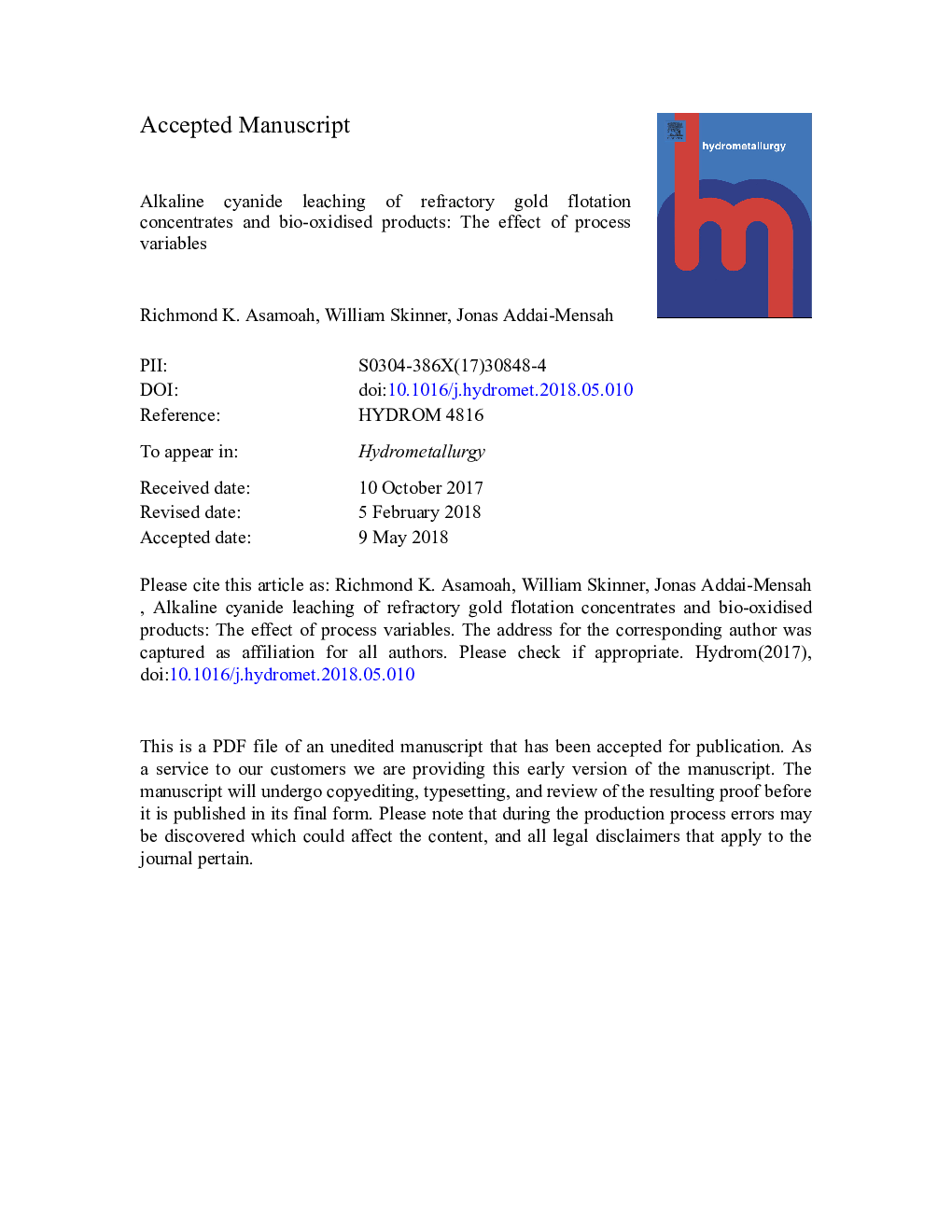| کد مقاله | کد نشریه | سال انتشار | مقاله انگلیسی | نسخه تمام متن |
|---|---|---|---|---|
| 6658850 | 1425525 | 2018 | 33 صفحه PDF | دانلود رایگان |
عنوان انگلیسی مقاله ISI
Alkaline cyanide leaching of refractory gold flotation concentrates and bio-oxidised products: The effect of process variables
ترجمه فارسی عنوان
اشباع سیانور قلیایی از غلظت فلوتاسیون نسوز و محصولات بیو اکسید شده: اثر متغیرهای فرآیند
دانلود مقاله + سفارش ترجمه
دانلود مقاله ISI انگلیسی
رایگان برای ایرانیان
کلمات کلیدی
سنگ معدن طلای یخ، فلوتاسیون و کنسانتره بیو اکسید شده، کانی شناسی معدن و شیمی / الکتروشیمی، رفتار اشباع سیانید قلیایی، جذب سطحی،
موضوعات مرتبط
مهندسی و علوم پایه
مهندسی شیمی
مهندسی شیمی (عمومی)
چکیده انگلیسی
The less predictive nature of alkaline cyanide leaching, owing to its complex functional relationships, render most processing plants unproductive and subsequent shutdown. In this work, the mechanism and kinetics of alkaline cyanide leaching of the two refractory flotation gold concentrates and their bio-oxidised products, taken as surrogates, have been investigated under isothermal, batch conditions, together with a review of the cognate literature. Specifically, the influence of ore mineralogy, pH modifier (caustic soda and quicklime), agitation rate (600-1000â¯rpm) and time on the leaching behaviour has been studied at 30â¯Â°C and pHâ¯10.5â¯Â±â¯0.2 over 8â¯h period. The results showed that cyanide leaching of the refractory flotation concentrates did not significantly alter the ore mineralogy, regardless of the pH modifier deployed. In case of jarosite-free bio-oxidised product, gypsum and bassanite phases present were leached out completely whilst only bassanite was leached out from jarosite-bearing bio-oxidised product upon deploying caustic soda as pH modifier. Unlike the caustic soda, bassanite was not leached from the jarosite-free and jarosite-bearing bio-oxidised products when quicklime was used to modify the pulp pH. In addition, increasing the agitation rate did not show any impact on the rate and yield of leaching the flotation concentrates. On the other hand, the rate and yield of leaching the bio-oxidised products increased with increasing agitation rate in an ore-type dependent manner. The gold leaching rates were greater within the initial 60â¯min than the later 420â¯min. The use of quicklime generally reduced the gold leaching rates compared with the caustic soda, however, certain variations, dependent on the ore mineralogy were observed within the initial 30â¯min. The leaching kinetics and mechanism of the flotation concentrates followed a chemical reaction controlled, shrinking core model whilst their corresponding bio-oxidised products followed a porous layer diffusion controlled, shrinking core model, both in a two-stage manner. The observed gold leaching rates were ~ 3-4 orders of magnitude lower than those reported for some sulphidic and oxidised gold ores, reflecting the refractoriness of the ores under investigation. The findings highlight the pivotal role complex, refractory ore mineralogy and its variation, pretreatment, process chemistry and applied mechanical action play in judicious manipulation and control of gold leach behaviour and extraction efficacy.
ناشر
Database: Elsevier - ScienceDirect (ساینس دایرکت)
Journal: Hydrometallurgy - Volume 179, August 2018, Pages 79-93
Journal: Hydrometallurgy - Volume 179, August 2018, Pages 79-93
نویسندگان
Richmond K. Asamoah, William Skinner, Jonas Addai-Mensah,
